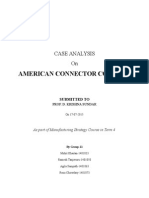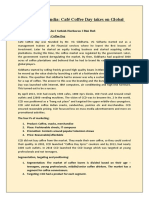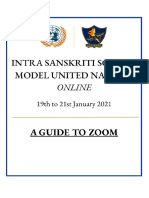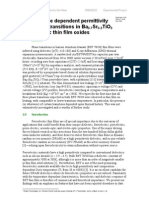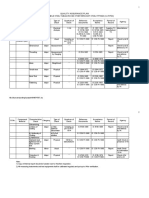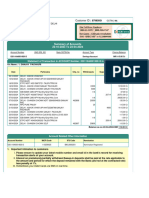Herman Miller Case Analysis
Herman Miller Case Analysis
Uploaded by
vivekCopyright:
Available Formats
Herman Miller Case Analysis
Herman Miller Case Analysis
Uploaded by
vivekOriginal Description:
Copyright
Available Formats
Share this document
Did you find this document useful?
Is this content inappropriate?
Copyright:
Available Formats
Herman Miller Case Analysis
Herman Miller Case Analysis
Uploaded by
vivekCopyright:
Available Formats
1.
Name:
2. The Case: Cradle-to-Cradle Design at Herman Miller: Moving Towards
Environmental Sustainability
3. Client: Herman Miller
4. The critical challenge faced by the client are following:
a) Use of PVC for arm-pad skins
b) Getting suppliers on board with regard to implementation of C2C
design methodology
c) How to get the used chairs back into the loop for recycling
Out of the above mentioned challenges the first one is of prime
importance and needs immediate attention.
5. The major stakeholders according to my understanding of the case and
their respective concerns are as follows:
Stakeholders
Concerns and Interests
Herman Miller and its officials
Environmental sustainability
is the prime objective of
Herman
Miller.
Their
concern is to successfully
implement
the
C2C
approach in design and
manufacturing
of
Mirra
chair.
Due to the use of cradle-to
cradle
approach
in
designing the Mirra chair, a
lot of new materials need to
be sourced. Suppliers are
required to disclose their
product
configuration.
Changes in the formulation
or on many occasions
completely new materials
are required to be supplied.
Mirra chair is one of the first
products
designed
according to the cradle-tocradle
approach,
the
success of this product will
determine the future of C2C
approach.
Suppliers
MBDC
6. The challenge being faced by Herman Miller is whether to use PVC for armpads or not. The root issue they need to resolve is to find an alternative for
PVC which is as efficient and economical as PVC, develop new tooling and
assembly line suiting the new material or modify the existing one.
7. The various possible options to resolve the challenges are:
a) Search for newer materials which can be effective replacements for
PVC and in the longer run develop new materials which have better
performance than PVC and are cheaper
b) Continue with PVC as the production line has already been designed
according to PVC arm pads. Also the switching cost from PVC to any
new material will be high in terms of revamping the supply chain.
8. I would recommend Herman Miller to replace PVC with the new material
TUP at the same time continue their research to find a better substitute. To
support my recommendation I would like to bring to fore the following
arguments:
a) According to the DeF scorecard 91% of material chemistry by
weight falls within the green and yellow categories. By making only
one more material adjustment the recyclability can be increased to
100%.
b) Perception is a powerful driver in any industry, and the use of PVC in
Mirra chair will be a threat to that image of environmental
consciousness that the company has created for itself so
painstakingly.
c) PVC produces toxins during its manufacturing process. This will not
only harm their employees health, but also damage the
environment.
d) PVC releases toxins in a fire. This makes it a high risk material for
office equipment and furniture
e) Herman Miller has always adopted environmental sustainability as
part of its core value. Since PVC is not environmentally friendly, and
against Herman Millers dedication towards sustainable design, it
should not use PVC, as it will damage its brand.
9. In order to implement the endeavour successfully Herman Millar might
face some hurdles which need to be addressed. First, there might be
issues regarding vendors and suppliers. This can be solved by letting the
suppliers know the tangible benefits of the undertaking and educating
them about the benefits of C2C design methodology. Second, the company
might face issues in terms of closing the loop. It will not easy to develop
competency to collect the used chairs and dismantle them for reuse. The
company needs to develop a separate mechanism to collect the used
chairs and bring them back to the manufacturing cycle. Third, the
company may use TUP for the time being as there is no better option, but
it needs to search for cheaper and more efficient replacements of TUP for
future use. They also need to improve the DeF score by working on other
components of the product. At present the DeF score is 61%.
You might also like
- Sumit Saurav - Cradle-To-Cradle Design at Herman Miller Moving Towards Environmental SustainibilityDocument6 pagesSumit Saurav - Cradle-To-Cradle Design at Herman Miller Moving Towards Environmental Sustainibilitysumit saurab67% (3)
- Adolph Coors in The Brewing IndustryDocument2 pagesAdolph Coors in The Brewing Industrysamadabbas00275% (4)
- Herman Miller CaseDocument3 pagesHerman Miller CaseJoetang04100% (1)
- LRDocument14 pagesLRasaNo ratings yet
- Hampshire ExpressDocument29 pagesHampshire Expressvivek0% (1)
- Blitz Case Write-UpDocument2 pagesBlitz Case Write-Upvivek100% (2)
- Leitax CaseDocument16 pagesLeitax CaseAndres Felipe Otalora CaicedoNo ratings yet
- Curled Metal Inc.-Case Discussion Curled Metal Inc. - Case DiscussionDocument13 pagesCurled Metal Inc.-Case Discussion Curled Metal Inc. - Case DiscussionSiddhant AhujaNo ratings yet
- Group 1 Donner Company CaseDocument7 pagesGroup 1 Donner Company CaseAjay Kumar100% (1)
- Group1 Sec A OM CasestudyDocument8 pagesGroup1 Sec A OM CasestudyUpdesh ChauhanNo ratings yet
- Sweet Water Case StudyDocument2 pagesSweet Water Case Studynirvick02050% (2)
- Discussion Questions - D.light CaseDocument2 pagesDiscussion Questions - D.light CaseAhmad DaasNo ratings yet
- Cisco ERP v12 - Case Study AnalysisDocument20 pagesCisco ERP v12 - Case Study AnalysisNitish ShahNo ratings yet
- Computron Inc NotesDocument4 pagesComputron Inc Notesfrenchy15100% (1)
- MDCM, Inc. (A) : IT Synchronization StrategyDocument5 pagesMDCM, Inc. (A) : IT Synchronization StrategyTalha MehmudNo ratings yet
- Pre Class Assignment Clique PensDocument2 pagesPre Class Assignment Clique PensBernadeta Pramudya WardhaniNo ratings yet
- Solution To Sport Obermeyer Case Study: IntroductionDocument5 pagesSolution To Sport Obermeyer Case Study: IntroductionZeen khan100% (1)
- American Connector Company: Case Analysis OnDocument10 pagesAmerican Connector Company: Case Analysis OnrenuNo ratings yet
- Nike Case Study PDFDocument3 pagesNike Case Study PDFEvans MettoNo ratings yet
- 5-Minute Daily Practice - Writing (NRevill v1)Document64 pages5-Minute Daily Practice - Writing (NRevill v1)Cristina Liliana93% (15)
- Dissertation: Drop, Cop, Flip: The Reselling PhenomenonDocument61 pagesDissertation: Drop, Cop, Flip: The Reselling PhenomenonSarah WongNo ratings yet
- Group 2I - Herman Miller Case AnalysisDocument7 pagesGroup 2I - Herman Miller Case AnalysisRishabh Kothari100% (1)
- Cradle To Cradle Design at Herman Miller: by Group MDocument10 pagesCradle To Cradle Design at Herman Miller: by Group MParas AgarwalNo ratings yet
- Cradle To CradleDocument31 pagesCradle To Cradleabhrajeet100% (2)
- Craddle To Craddle Design at Herman Miller: Case Study: Sumbitted by (Group 1)Document14 pagesCraddle To Craddle Design at Herman Miller: Case Study: Sumbitted by (Group 1)Chetan SahuNo ratings yet
- Herman Miller Case StudyDocument5 pagesHerman Miller Case StudyVishal DaveNo ratings yet
- BOS Brands - Group 6Document7 pagesBOS Brands - Group 6rishi ranjanNo ratings yet
- C2C Herman Miller PPT (Group B)Document8 pagesC2C Herman Miller PPT (Group B)Gaurav Shroff100% (1)
- Newell CompanyDocument26 pagesNewell CompanyAnirudh Kowtha100% (1)
- Group 3 Assignment 6Document2 pagesGroup 3 Assignment 6Suraj ChaudharyNo ratings yet
- Coffee Wars - Case Report - Team ADocument2 pagesCoffee Wars - Case Report - Team ARini RafiNo ratings yet
- Presentation OF A Casestudy CADBURY SCHWEPPES Capturing Confectioner (D)Document17 pagesPresentation OF A Casestudy CADBURY SCHWEPPES Capturing Confectioner (D)Sadiq Sagheer50% (2)
- Itt Automotive: Global Manufacturing Strategy (1994)Document25 pagesItt Automotive: Global Manufacturing Strategy (1994)Varun Chandel100% (1)
- Group 2 Michigan Manufacturing CorporationDocument22 pagesGroup 2 Michigan Manufacturing CorporationtheplacementcircleNo ratings yet
- Halloran MetalsDocument5 pagesHalloran Metalssuraj ksNo ratings yet
- Assignment: Kunst 1600 Case AnalysisDocument5 pagesAssignment: Kunst 1600 Case AnalysisSheffin SamNo ratings yet
- Group-7 Sec-G Om-I Project Report - Benihana in TokyoDocument10 pagesGroup-7 Sec-G Om-I Project Report - Benihana in TokyoRohit SinghNo ratings yet
- Marketing Management - Decision Sheet Chotukool: "Little Cool," Big OpportunityDocument1 pageMarketing Management - Decision Sheet Chotukool: "Little Cool," Big OpportunityNILANJAN MUKHERJEENo ratings yet
- Group2 ITT CaseDocument16 pagesGroup2 ITT CaseAman Anshu100% (1)
- American Connector Company: Case Analysis ReportDocument5 pagesAmerican Connector Company: Case Analysis ReportKalyan MukkamulaNo ratings yet
- CMI CaseDocument4 pagesCMI CaseSaurabh BoseNo ratings yet
- Case Analysis - Wright Line, Inc. (A)Document8 pagesCase Analysis - Wright Line, Inc. (A)ayush singlaNo ratings yet
- Dominion Motors Controls Ltd.Document4 pagesDominion Motors Controls Ltd.Naveen Chander DharNo ratings yet
- Sport Obermeyer CaseDocument4 pagesSport Obermeyer CaseNamita DeyNo ratings yet
- EkohealthDocument3 pagesEkohealthSARATH RAM P PGP 2019-21 BatchNo ratings yet
- 426 Wine Case Q2Document2 pages426 Wine Case Q2Elaine Chan100% (1)
- Computron IncDocument7 pagesComputron IncJD_04100% (1)
- CmiDocument10 pagesCmiSanket GhelaniNo ratings yet
- The Aquatred LaunchDocument7 pagesThe Aquatred LaunchAditya SoumavaNo ratings yet
- Natureview Case StudyDocument3 pagesNatureview Case StudySheetal RaniNo ratings yet
- HP CompaqDocument46 pagesHP CompaqManish Mahato100% (1)
- IMC A - Group 9 - Mountain DewDocument5 pagesIMC A - Group 9 - Mountain DewPulokesh GhoshNo ratings yet
- American Connector Company: Case AnalysisDocument5 pagesAmerican Connector Company: Case AnalysisSam SamNo ratings yet
- Solectron Cases - 1Document36 pagesSolectron Cases - 1kundan50% (2)
- Sport Obermeyer (Handout)Document24 pagesSport Obermeyer (Handout)06818908d100% (2)
- Rank Xerox CaseDocument9 pagesRank Xerox CaseVarun KhannaNo ratings yet
- Ben and Jerry's Homeland Ice Cream Inc.: - A Period of TransitionDocument3 pagesBen and Jerry's Homeland Ice Cream Inc.: - A Period of TransitionAnand SinghNo ratings yet
- Herman MillerDocument3 pagesHerman MillerCHAYA GOWDANo ratings yet
- Cradle To Cradle Case IssuesDocument3 pagesCradle To Cradle Case Issuesplum_shiNo ratings yet
- C2C DesignDocument5 pagesC2C DesignNancy ByronNo ratings yet
- Cradle To Cradle Design AT: Presented By: Group 3Document21 pagesCradle To Cradle Design AT: Presented By: Group 3Anonymous sMqylHNo ratings yet
- Product Development Processes A Case Study in Sustainable Product Design: Herman Miller, IncDocument2 pagesProduct Development Processes A Case Study in Sustainable Product Design: Herman Miller, Incarbitid01No ratings yet
- Cradle-to-Cradle Design at Herman Miller: Moving Toward Environmental SustainabilityDocument15 pagesCradle-to-Cradle Design at Herman Miller: Moving Toward Environmental Sustainabilitysn0134No ratings yet
- Design For The Next Generation: Incorporating Cradle-to-Cradle Design Into Herman Miller ProductsDocument18 pagesDesign For The Next Generation: Incorporating Cradle-to-Cradle Design Into Herman Miller ProductsJesús Rafael Páez LópezNo ratings yet
- Valuation in The Airline Industry Excel FileDocument12 pagesValuation in The Airline Industry Excel FilevivekNo ratings yet
- Case Robin HoodDocument1 pageCase Robin HoodKartikeya SengarNo ratings yet
- Operational PlanDocument3 pagesOperational PlanvivekNo ratings yet
- AE SpecificationDocument9 pagesAE SpecificationRusuVasileCristianNo ratings yet
- Mbas2om PDFDocument12 pagesMbas2om PDFJorge Hernández CruzNo ratings yet
- English - 7 Steps Behind Manufacturing JeeniDocument2 pagesEnglish - 7 Steps Behind Manufacturing Jeenijp9hyzcct6No ratings yet
- Niko Tracks PDFDocument52 pagesNiko Tracks PDFTomekNo ratings yet
- Ro1 LQF Qad 017Document4 pagesRo1 LQF Qad 017MichiOdevilasNo ratings yet
- Biosensor Based On Horseradish Peroxidase ImmobilizedDocument9 pagesBiosensor Based On Horseradish Peroxidase ImmobilizedNegreanuDenisaValentinaNo ratings yet
- Lists of Manlilikha NG Bayan G2Document26 pagesLists of Manlilikha NG Bayan G2tjhunter077No ratings yet
- Method Statement For Construction of Road EmbankmentDocument9 pagesMethod Statement For Construction of Road EmbankmentAnonymous a3K3Wg100% (2)
- RAAH Group Inc - USA Safety BrochureDocument26 pagesRAAH Group Inc - USA Safety BrochureRAAH Group IncNo ratings yet
- Snuggler Gear Reducer FA40A: Sew-Eurodrive, IncDocument2 pagesSnuggler Gear Reducer FA40A: Sew-Eurodrive, InccmaradiagaNo ratings yet
- KASAMBAHAYDocument8 pagesKASAMBAHAYjowie james octatNo ratings yet
- Finals Topics 5-9Document16 pagesFinals Topics 5-9Pink WandererNo ratings yet
- Tutorial Free Range VHDLDocument192 pagesTutorial Free Range VHDLEdison BaiakNo ratings yet
- INTRA SMUN - Zoom GuideDocument11 pagesINTRA SMUN - Zoom GuidevidushiNo ratings yet
- Dungeon Masterx27s KitDocument180 pagesDungeon Masterx27s KitpixeldeliveryNo ratings yet
- Nur 460 Capstone Practicum LogDocument3 pagesNur 460 Capstone Practicum Logapi-559074394No ratings yet
- Barium Strontium TitanateDocument15 pagesBarium Strontium Titanatekanita_jawwNo ratings yet
- GeneralPhysics12 Q3 Ver4 Mod2 Electric-Potential-version4Document19 pagesGeneralPhysics12 Q3 Ver4 Mod2 Electric-Potential-version4belloheideliza2No ratings yet
- Case Studies in Thermal Engineering: Vipin B. Gawande, A.S. Dhoble, D.B. Zodpe, Sunil ChamoliDocument13 pagesCase Studies in Thermal Engineering: Vipin B. Gawande, A.S. Dhoble, D.B. Zodpe, Sunil ChamoliArif KurniawanNo ratings yet
- Quality Assurance PlanDocument4 pagesQuality Assurance PlanNaveen NagisettiNo ratings yet
- SDS00164001103 Pfeiffer P3 Vacuum Pump OilDocument9 pagesSDS00164001103 Pfeiffer P3 Vacuum Pump OilRamon KleytonNo ratings yet
- 12a - Dispersion ModellingDocument24 pages12a - Dispersion ModellingGAEL MICHEL-GROSJEANNo ratings yet
- 9presentation USM Civil On RecyclingDocument116 pages9presentation USM Civil On RecyclingNasrulNo ratings yet
- Victory Insider - Gulf StrikeDocument13 pagesVictory Insider - Gulf StrikeThomas C Duensing100% (1)
- Arnis Grade 7 2nd QDocument30 pagesArnis Grade 7 2nd QBea Valerie GrislerNo ratings yet
- The Pandemic Century - One Hundr - Mark HonigsbaumDocument356 pagesThe Pandemic Century - One Hundr - Mark HonigsbaumJanna AncicoNo ratings yet
- IdbiDocument3 pagesIdbisanjay.pachauri93No ratings yet

















